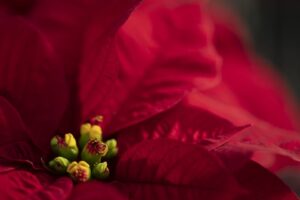Crop Protection in Poinsettias from Stick to Finish

It is always important to scout incoming plants upon arrival so the growing season kicks off with a clean start. Photos: Syngenta
Poinsettia season is just around the corner, so reviewing potential pest problems that may arise during production can help growers prepare for a successful season. There are several insect pests to watch for during the poinsettia propagation and production phases of growth, including fungus gnats (adults and larvae), thrips, whitefly, and mites. While intensive scouting is conducted on offshore stock plants as part of an integrated pest management program to reduce the incidence of pests from coming in with the cuttings, it is always important to scout incoming plants upon arrival so you can be sure you are getting off to a clean start.
Fungus Gnats — Adults and Larvae
Root and stem injury caused by fungus gnat larval feeding can often begin during mid-late stages of propagation. This is especially true in direct stick programs and in propagation areas that have not been properly sanitized to remove algae from the growing area. Fungus gnat larvae can bore into the base of stems as well as feed on callus tissue and roots, restricting root growth and providing an entry point for disease-causing pathogens. Periodically inspect developing callus and roots for larvae and monitor adult populations by placing yellow sticky cards several inches above the crop canopy. If larvae are detected or adult populations are starting to build, drench the planting media/root zone with Citation insect growth regulator and repeat in 10 days if needed. The parasitic nematode Steinernema feltiae has also been effective for controlling fungus gnats and can be applied toward the end of propagation or later in production.
Thrips
Injuries from thrips have become a common problem on young poinsettia plants in production, as they are easily carried over from the production of spring and summer crops. Thrips feed primarily on young, tender leaves and can cause severe leaf distortion and scarring once these leaves expand and mature. The key to preventing this damage is to scout the crop regularly, use blue or yellow sticky cards to monitor adult populations, and use a rotation of effective insecticides with different modes of action to prevent the population from building. Products such as Avid miticide/insecticide and Mainspring GNL insecticide are good choices since they have good activity against whitefly, too. Other effective insecticides that can be used include Overture, Conserve, or XXpire.

Poinsettia season is just around the corner, so reviewing potential pest problems that may arise during production can help growers prepare for a successful season.
Whitefly
Poinsettia is a favorite host for this pest, so scouting and monitoring activities should start early and continue throughout the production cycle. If possible, inspect a small percentage of the cuttings prior to stick for the presence of eggs, immature stages, or adults. After sticking, continue to scout the crop regularly for whitefly activity by examining the underside of the leaves for their presence. Use yellow sticky cards throughout production areas to monitor adult activity. If eggs or immature stages are detected or adult activity is evident, apply Avid miticide/insecticide at 8 ounces per 100 gallons for control. Avid controls both B and Q biotypes of Bemisia tabaci and will prevent immature stages from developing further. Avid may also be used on bracts in color. Additional products that can be used to control whiteflies include Sanmite miticide/insecticide, which is effective for controlling both biotypes. Insecticides in Insecticide Resistance Action Committee (IRAC) group 9 are also effective as sprays for controlling whiteflies; this includes products such as Endeavor or Rycar insecticides.
For extended protection and control of whiteflies (11+ weeks), a systemic insecticide, such as Mainspring GNL, should be applied as a drench, ideally by the end of September or early October. The optimal timing for this application is two to three weeks after the crop is pinched and before whitefly populations begin to build. At this point, the crop is well rooted after transplanting, which allows for optimum uptake of the insecticide. Prior to making a drench application, check the amount of drench solution needed to wet 2∕3 to 3/4 of your root zone for each container size in production. Drench volumes can vary depending upon the type of planting media used. If your whitefly populations tend to be very low and you prefer to spray, two applications can be made two weeks apart, as part of a rotational program.
How to Control Whitefly Populations with Mites
For those growers pursuing a biological program, there are also several beneficial insects that can be used to control whitefly populations. The predatory mite Amblyseius swirskii feeds on whitefly eggs and young nymphs. This is most effective when used in conjunction with the parasitoid Eretmocerus eremicus, which controls both greenhouse whitefly (trialeurodes) and silverleaf whitefly (bemisia) species. Both biologicals can be released 10 days after an Avid application and are also compatible with Mainspring GNL sprays and drench applications.
The Lewis mite (Eotetranychus lewisi) and two-spotted spider mite (Tetranychus urticae) can also be occasional pests of poinsettias. Both mites tend to congregate and feed on the undersides of leaves, causing a chlorotic spot to develop at each feeding site. Over time, the injury will result in leaves having a stippled appearance. Injury from the Lewis mite can often resemble and be misdiagnosed as a nutrient deficiency. Although somewhat similar in appearance, the Lewis mite is smaller and has several small spots on its body compared to the two-spotted spider mite. Early applications of Avid or Sanmite will prevent these mites from building and becoming a problem. Since these products also have activity on whitefly, they can be used as part of a total pest management program for poinsettias.
Author’s note: Always read and follow label instructions. Some products may not be registered for sale or use in all states or counties. Please check with your local Extension Service to ensure registration status. Some or all of the varieties may be protected under one or more of the following: Plant Variety Protection, U.S. Plant Patents and/or Utility Patents and may not be propagated or reproduced without authorization.











